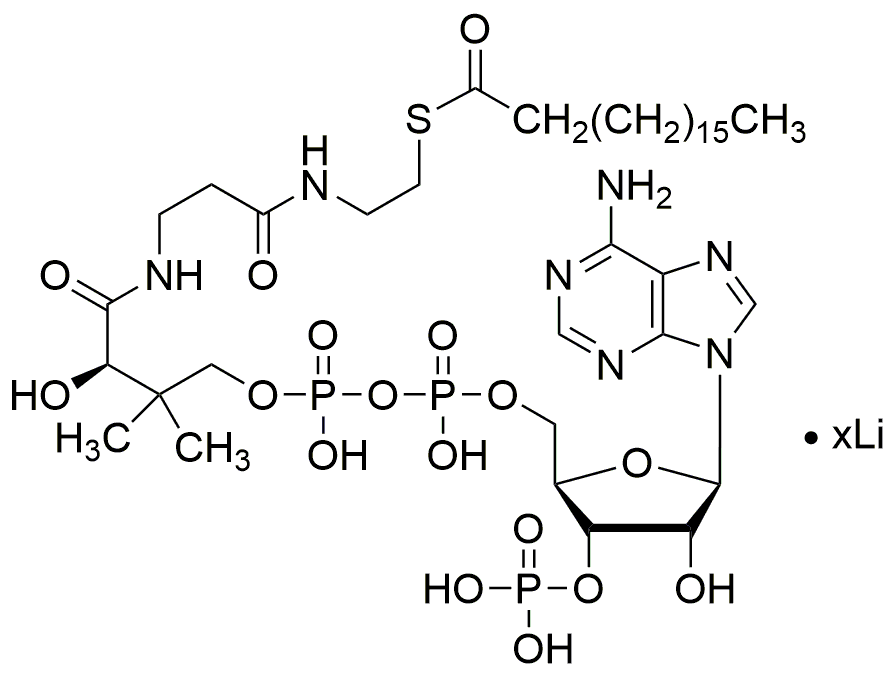Stearoyl coenzyme A lithium salt is widely utilized in research focused on:
- Biochemical Research: It serves as a substrate in enzymatic reactions, particularly in studies involving lipid metabolism and fatty acid synthesis, helping researchers understand metabolic pathways.
- Pharmaceutical Development: This compound is used in drug formulation processes, especially for creating liposomal drug delivery systems, enhancing the bioavailability of therapeutic agents.
- Cosmetic Industry: It acts as an emollient and thickening agent in skincare products, providing moisturizing benefits and improving product texture for better consumer experience.
- Food Industry: Employed as a food additive, it can enhance the stability and shelf life of certain products, making it valuable for food manufacturers aiming for quality and safety.
- Biotechnology: The compound is utilized in the production of biofuels and bioplastics, contributing to sustainable practices and reducing reliance on fossil fuels.
Informations générales
Propriétés
Sécurité et réglementation
Applications
Stearoyl coenzyme A lithium salt is widely utilized in research focused on:
- Biochemical Research: It serves as a substrate in enzymatic reactions, particularly in studies involving lipid metabolism and fatty acid synthesis, helping researchers understand metabolic pathways.
- Pharmaceutical Development: This compound is used in drug formulation processes, especially for creating liposomal drug delivery systems, enhancing the bioavailability of therapeutic agents.
- Cosmetic Industry: It acts as an emollient and thickening agent in skincare products, providing moisturizing benefits and improving product texture for better consumer experience.
- Food Industry: Employed as a food additive, it can enhance the stability and shelf life of certain products, making it valuable for food manufacturers aiming for quality and safety.
- Biotechnology: The compound is utilized in the production of biofuels and bioplastics, contributing to sustainable practices and reducing reliance on fossil fuels.
Documents
Fiches de données de sécurité (FDS)
La FDS fournit des informations de sécurité complètes sur la manipulation, le stockage et l’élimination du produit.
Spécifications du produit (PS)
Le PS fournit une description complète des propriétés du produit, notamment sa composition chimique, son état physique, sa pureté et les exigences de stockage. Il détaille également les plages de qualité acceptables et les applications prévues du produit.
Certificats d'analyse (COA)
Recherchez des certificats d'analyse (COA) en saisissant le numéro de lot du produit. Les numéros de lot et de lot se trouvent sur l'étiquette d'un produit, après les mots « Lot » ou « Lot de fabrication ».
Numéro de catalogue
Numéro de lot/série
Certificats d'origine (COO)
Ce certificat d'exploitation confirme le pays dans lequel le produit a été fabriqué, et détaille également les matériaux et composants utilisés et s'il est issu de sources naturelles, synthétiques ou autres sources spécifiques. Ce certificat peut être requis pour les douanes, le commerce et la conformité réglementaire.
Numéro de catalogue
Numéro de lot/série
Fiches de données de sécurité (FDS)
La FDS fournit des informations de sécurité complètes sur la manipulation, le stockage et l’élimination du produit.
DownloadSpécifications du produit (PS)
Le PS fournit une description complète des propriétés du produit, notamment sa composition chimique, son état physique, sa pureté et les exigences de stockage. Il détaille également les plages de qualité acceptables et les applications prévues du produit.
DownloadCertificats d'analyse (COA)
Recherchez des certificats d'analyse (COA) en saisissant le numéro de lot du produit. Les numéros de lot et de lot se trouvent sur l'étiquette d'un produit, après les mots « Lot » ou « Lot de fabrication ».
Numéro de catalogue
Numéro de lot/série
Certificats d'origine (COO)
Ce certificat d'exploitation confirme le pays dans lequel le produit a été fabriqué, et détaille également les matériaux et composants utilisés et s'il est issu de sources naturelles, synthétiques ou autres sources spécifiques. Ce certificat peut être requis pour les douanes, le commerce et la conformité réglementaire.


